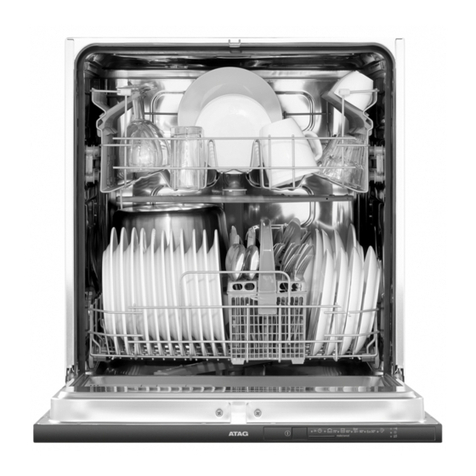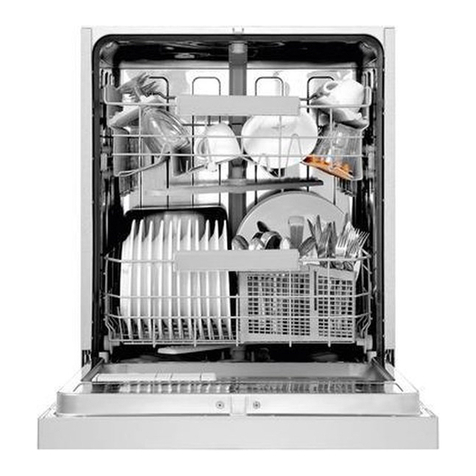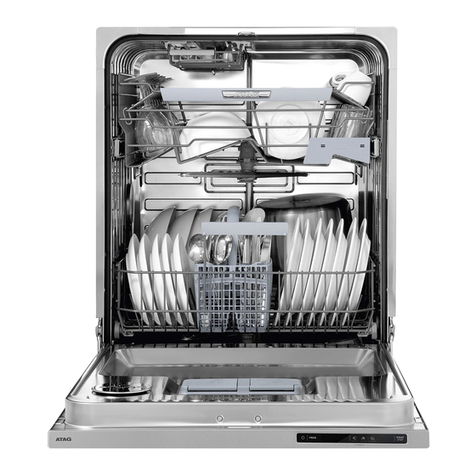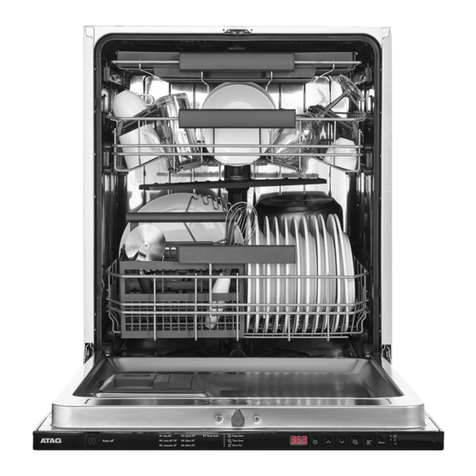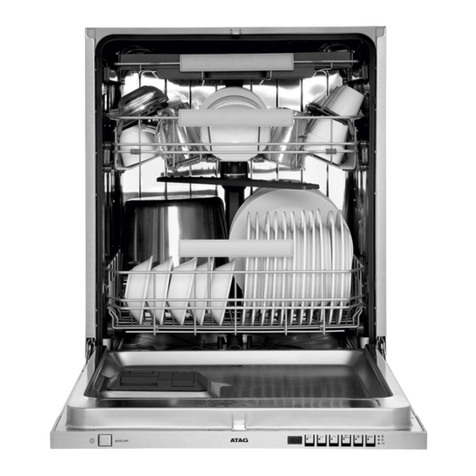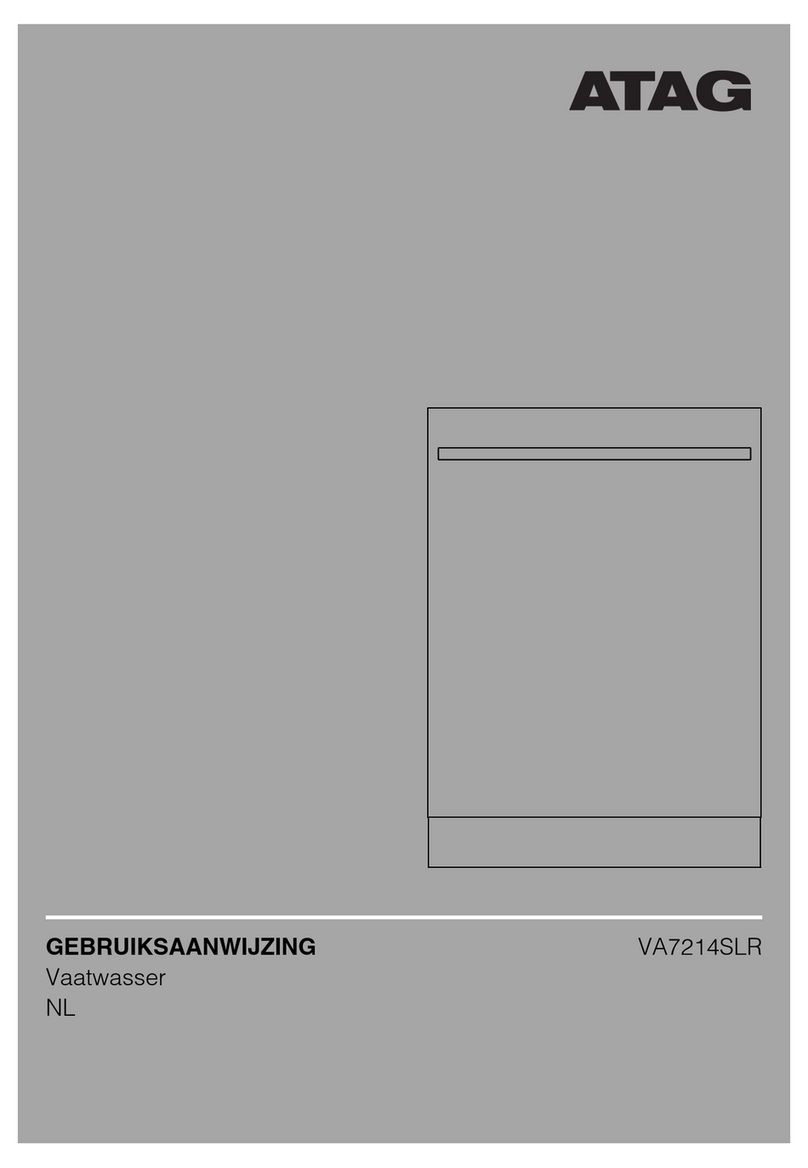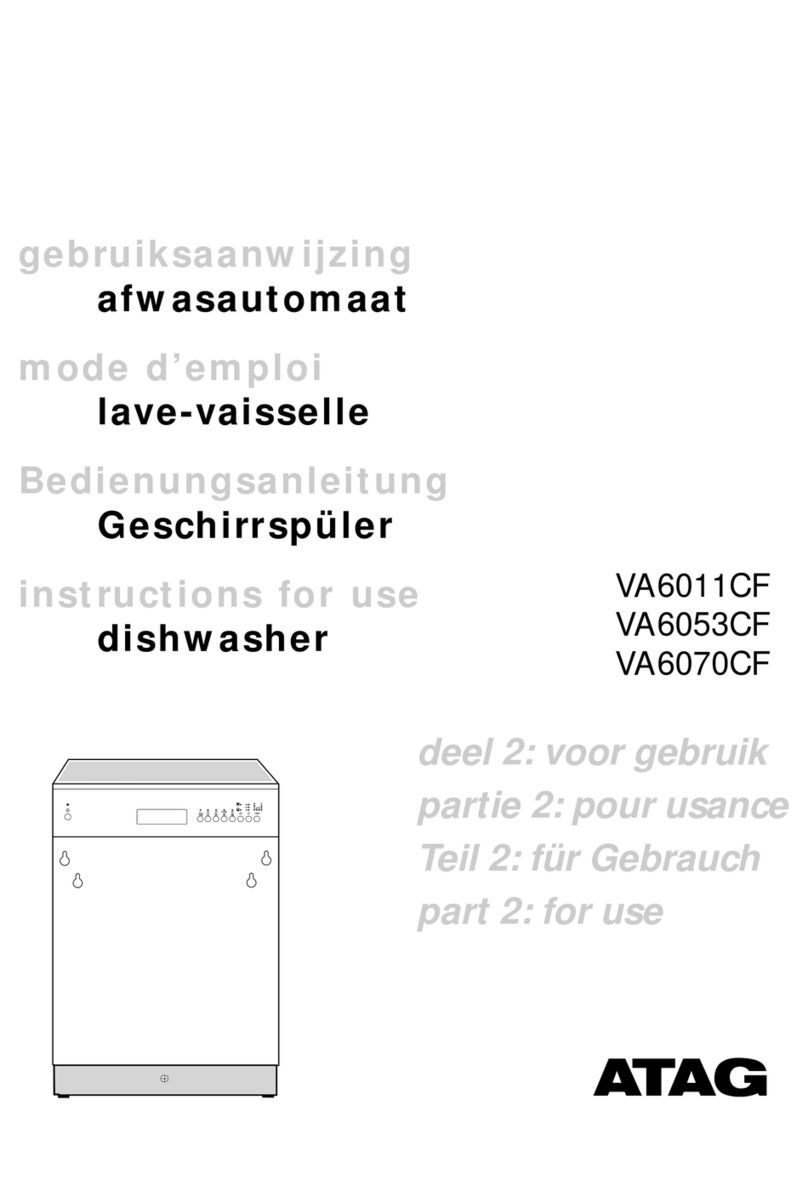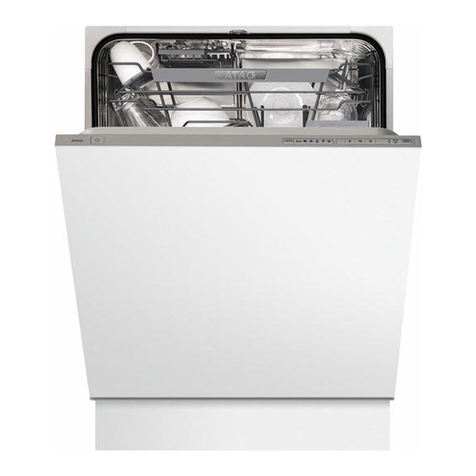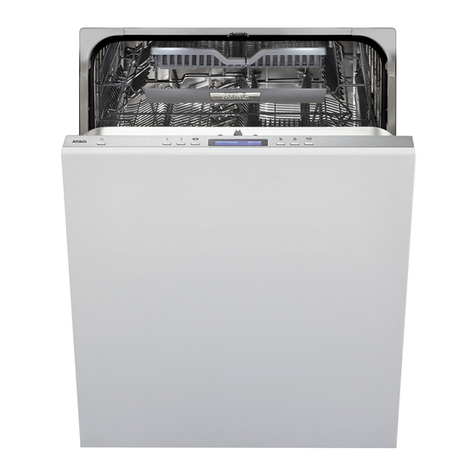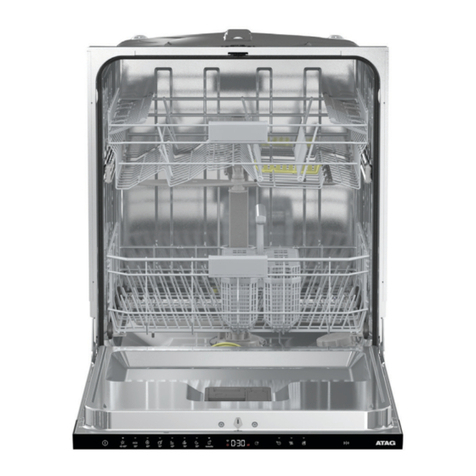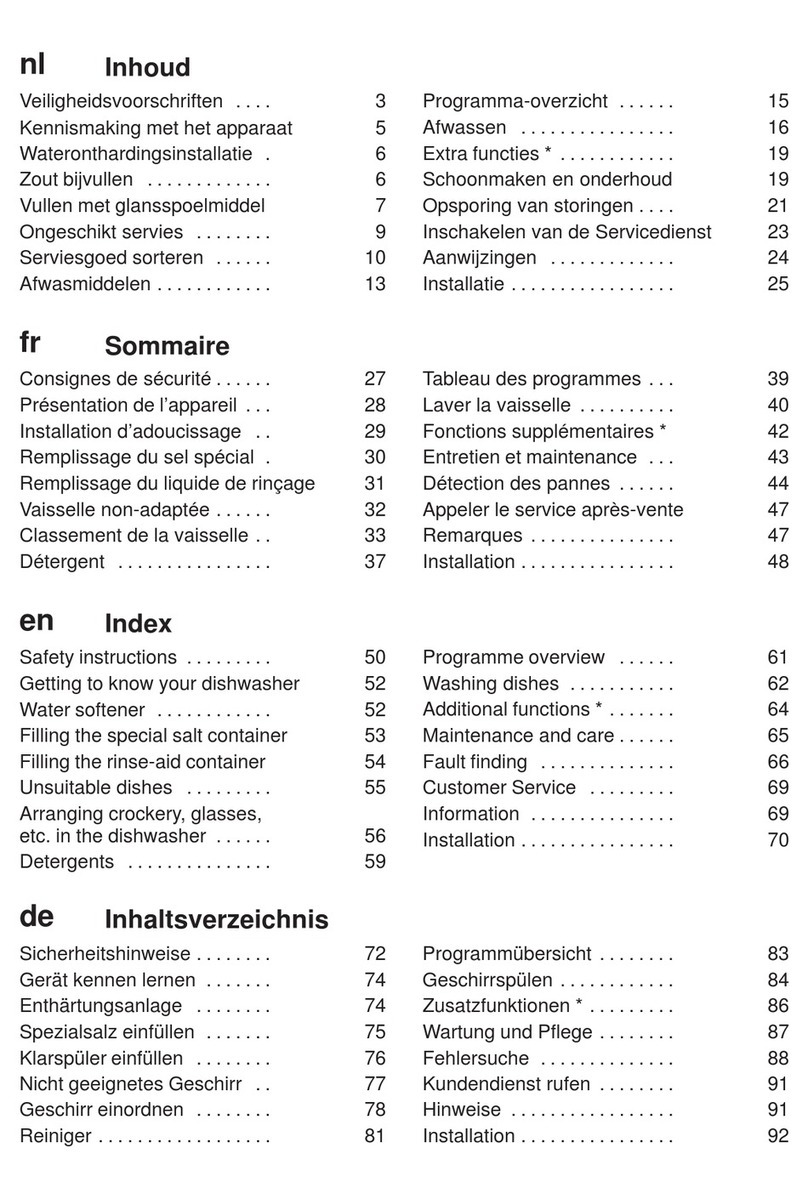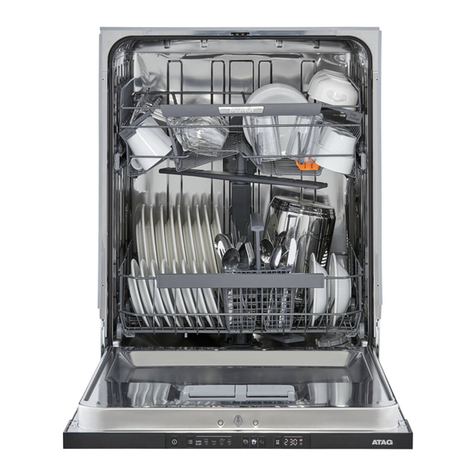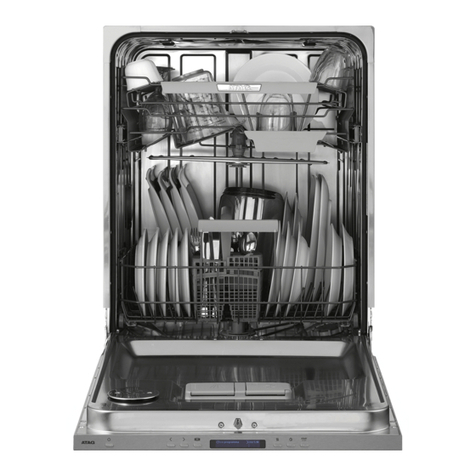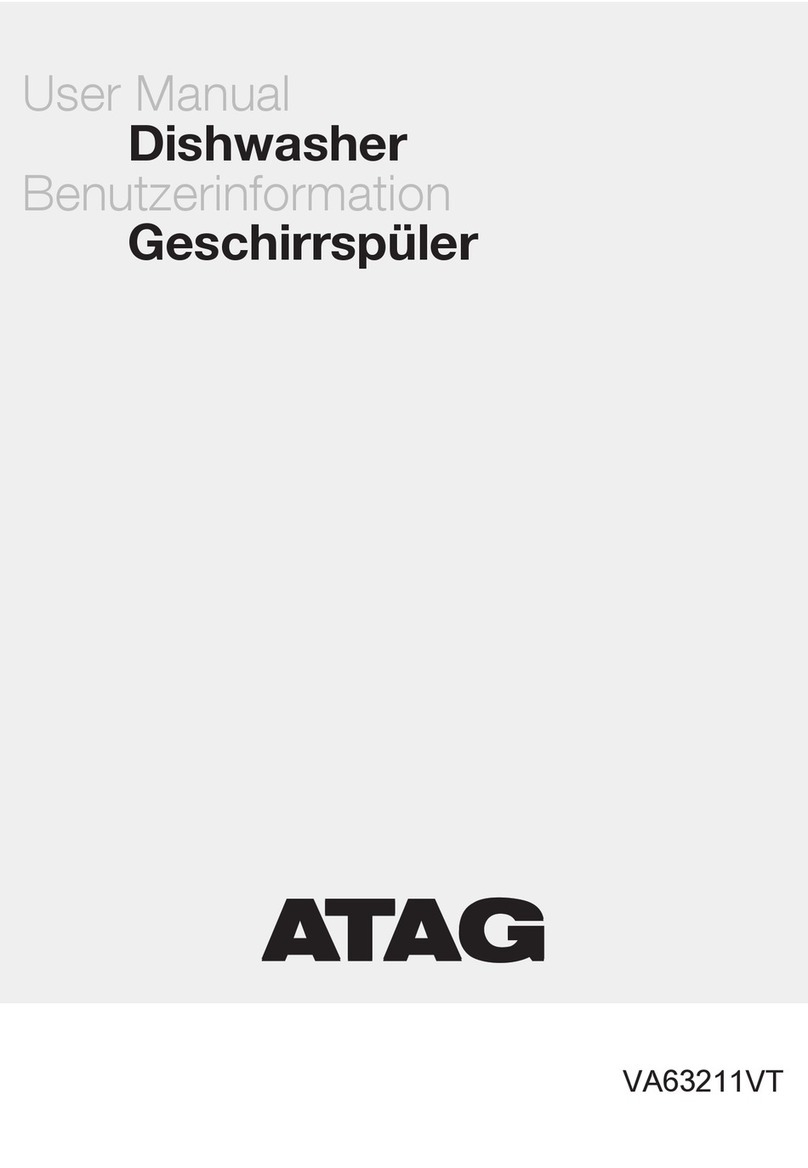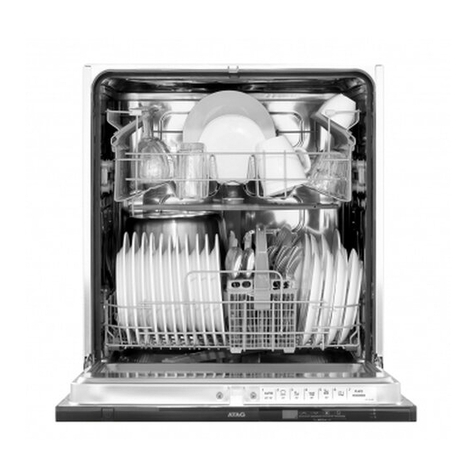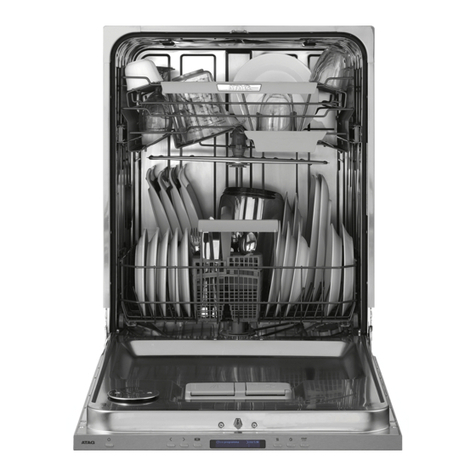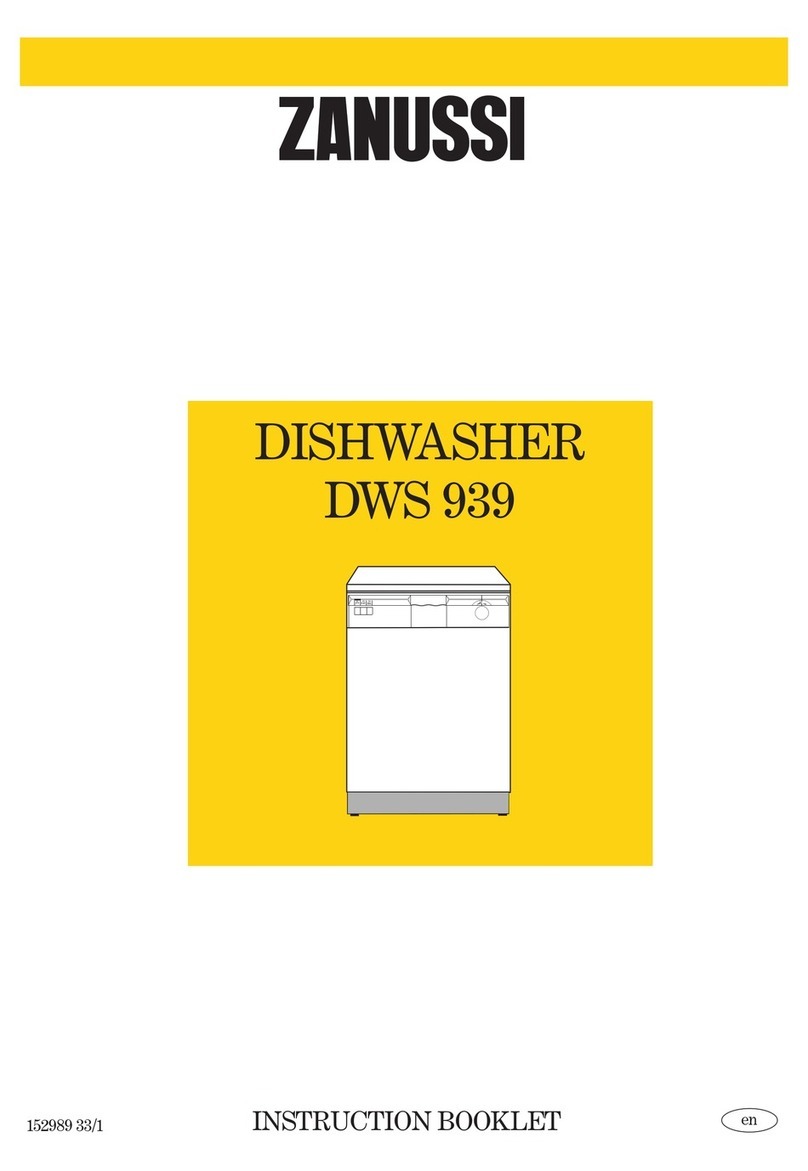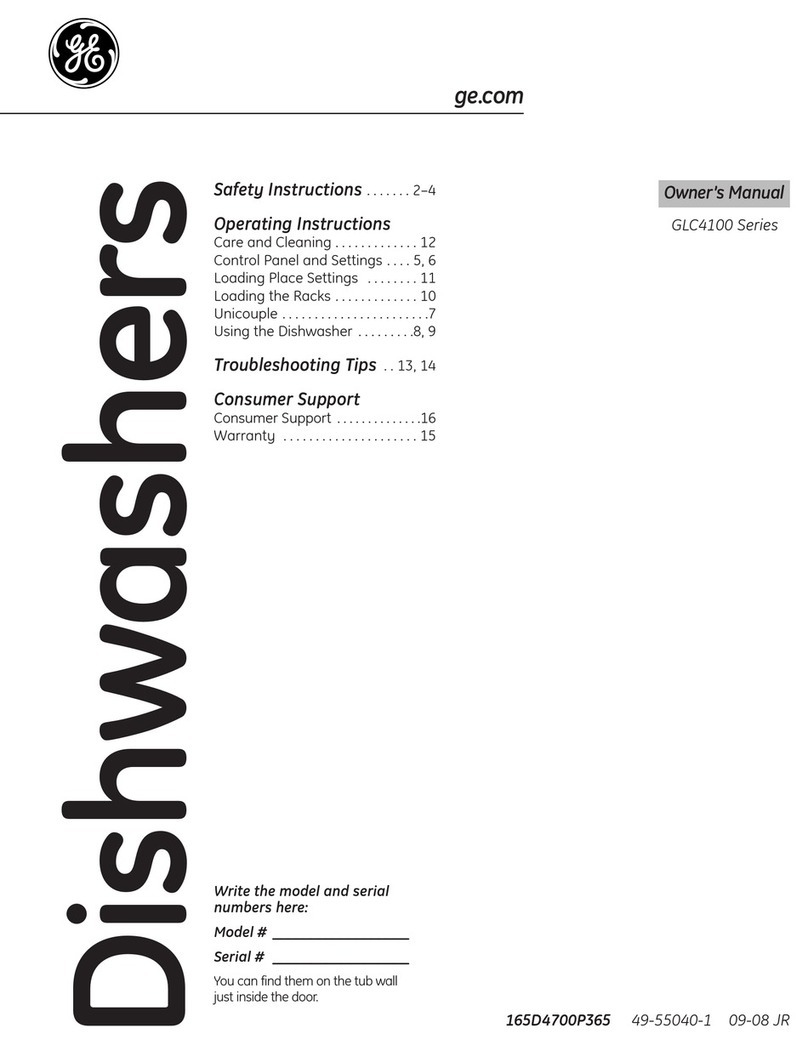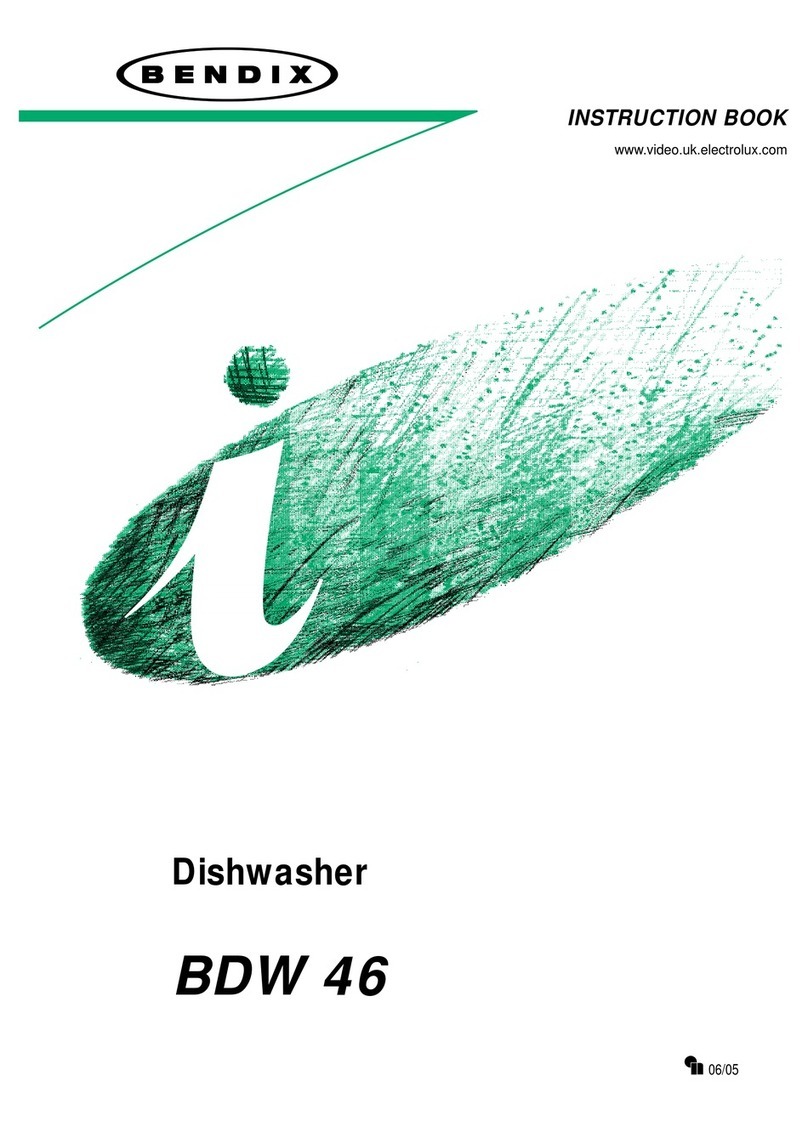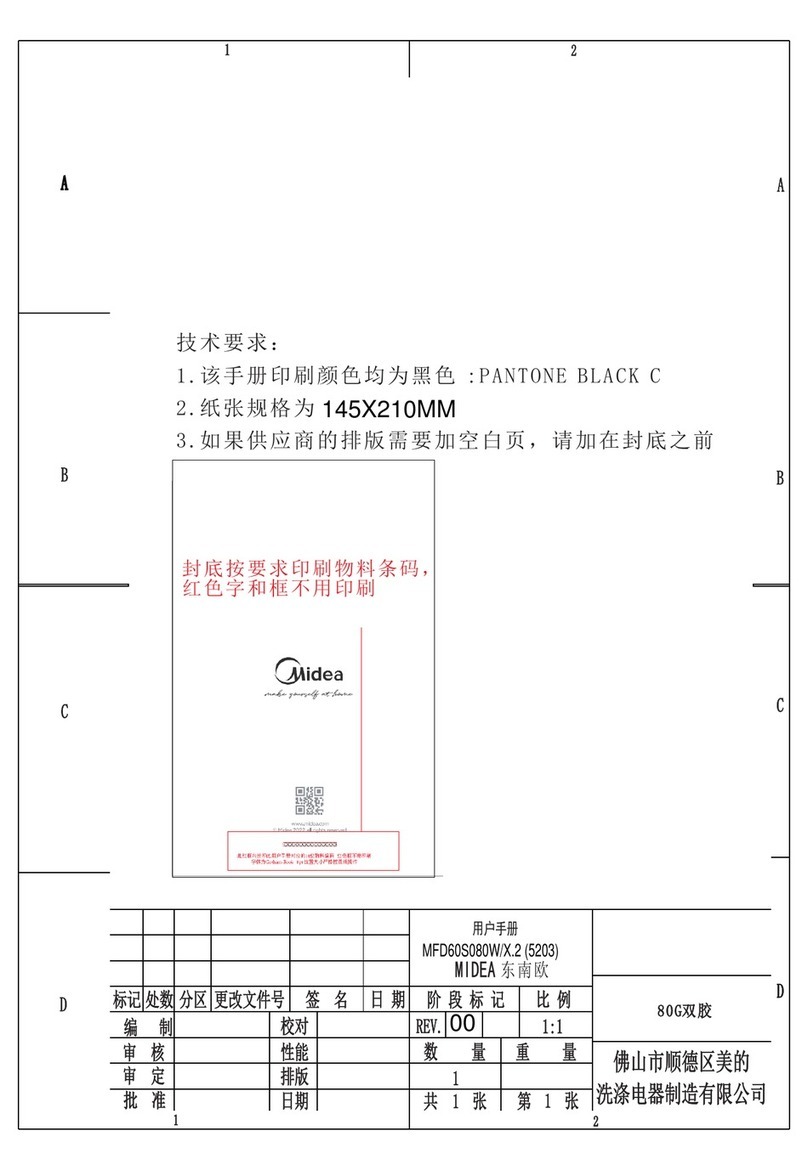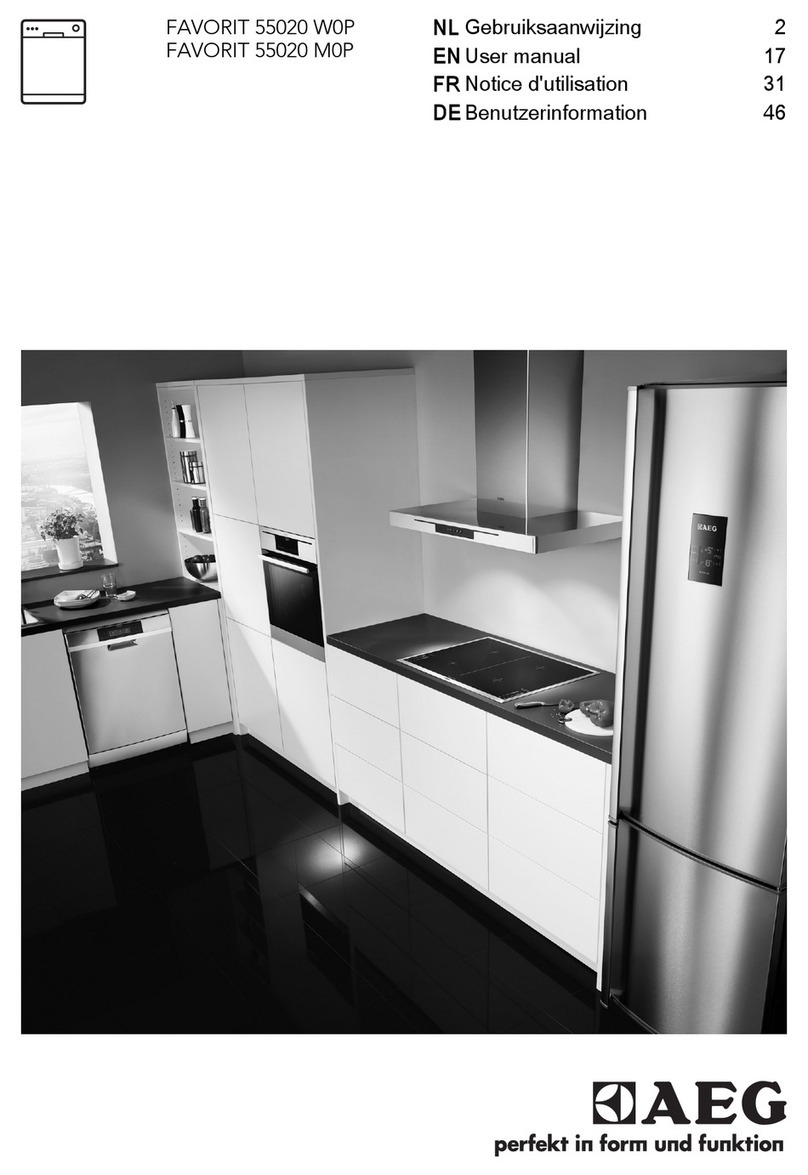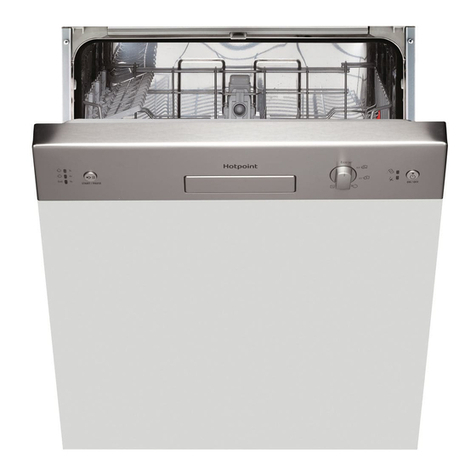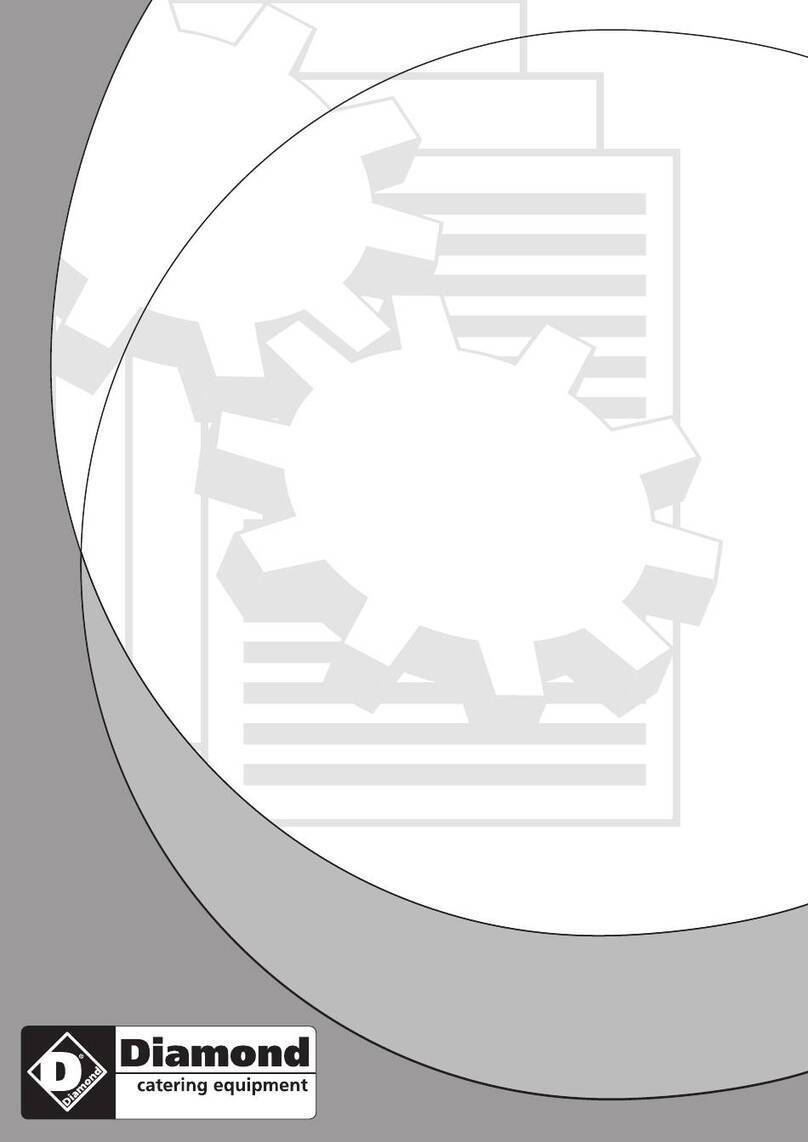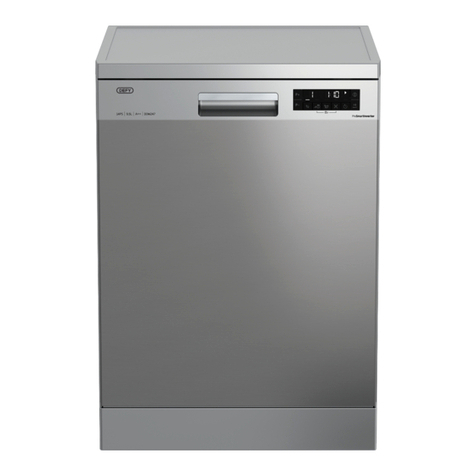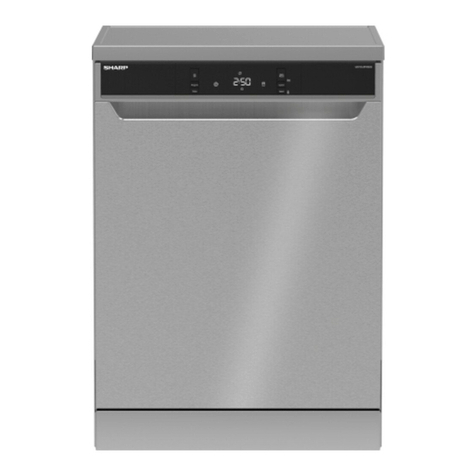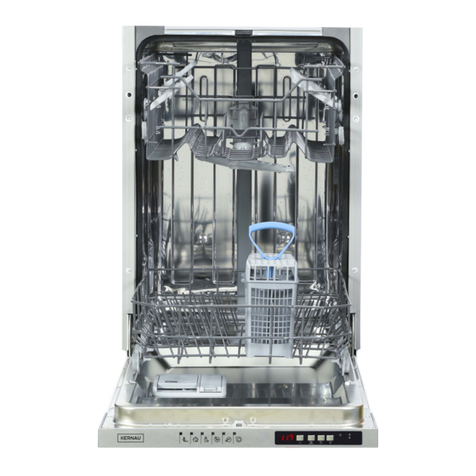Atag VA6011BT User manual

gebruiksaanwijzing
afwasautomaat
mode d’emploi
lave-vaisselle
Bedienungsanleitung
Geschirrspüler
instructions for use
dishwasher VA6011BT
COP04
deel 1: algemeen
partie 1: universal
Teil 1: algemein
part 1: general

45
Important safety information 46
Installation instructions 47
Water supply connections 47
Water outlet hose connection 48
Electrical connection 48
Before use 49
Setting the water softener 49
Filling with salt 50
Rinse aid 51
Use of detergent 52
Hints and tips 53
Maintenance and cleaning 54
Internal cleaning 54
Cleaning the filters 54
External cleaning 55
Prolonged periods of non-operation 55
Frost precautions 55
Moving the machine 55
Something not working 56
Service and spare parts 57
Protection against flooding 57
Hints for test centres 58
Technical specifications 58
Contents
Guide to use the instruction book
The following symbols will be found in the text to guide you throughout the instructions:
Safety instructions
1. 2. 3. Step by step
Hints and tips
Environmental information

46
Installation
●This appliance is heavy. Care should be taken when
moving it.
●It is dangerous to alter the specifications or attempt
to modify this product in any way.
●Care must be taken to ensure that the appliance
does not stand on the electrical supply cable.
●Any electrical work required to install this appliance
should be carried out by a qualified electrician or
competent person.
●Any plumbing work required to install this appliance
should be carried out by a qualified plumber or
competent person.
Child Safety
●This appliance is designed to be operated by
adults.
Children should not be allowed to tamper with the
controls or play with the product.
●Keep all packaging well away from children.
●Keep all detergents in a safe place out of children's
reach.
During Use
●Items that are contaminated by petrol, paint, steel
or iron debris, corrosive, acidic or alkaline
chemicals must not be washed in this dishwasher.
●Under no circumstances should you open the door
whilst the appliance is in operation. Always turn off
the appliance before opening the door.
●Only use detergent specifically designed for use in
dishwashers.
●Long bladed knives stored in an upright position are
a potential hazard.
●Long and/or sharp items of cutlery such as carving
knives must be positioned horizontally in the upper
basket.
●When finishing loading or unloading close the
door, as an open door can be a hazard.
●Do not sit or stand on the open door.
●Isolate the appliance from the power supply and
turn off the water supply after use.
●Care should be taken when cleaning the bottom
door seal and hinge area as any exposed metal
edges may cut if care is not taken.
●This product should be serviced by an
authorised Service engineer, and only genuine
spare parts should be used.
●Under no circumstances should you attempt to
repair the machine yourself. Repairs carried out
by inexperienced persons may cause injury or
serious malfunctioning. Contact your local
Service Force Centre. Always insist on genuine
spare parts.
Conservation
In the interest of the environment:
●Materials marked with the symbol are
recyclable.
●Check with your local Council or Environmental
Health Office to see if there are facilities in your
area for re-cycling this appliance.
●When the appliance is to be scrapped, cut off
the power supply cable and make the door
closing device unusable to prevent young
children from being trapped inside.
●Help to keep your country tidy - use authorised
disposal sites for your old appliance.
Important safety information
It is most important that this instruction book should be retained with the appliance for future
reference. Should the appliance be sold or transferred to another owner, or should you move house
and leave the appliance, always ensure that the book is left with the appliance in order that the new
owner can get to know the functioning of the appliance and the relevant safety information.
his information has been provided in the interest of your safety. You MUS read it carefully before
installing or using the appliance.

47
Remove all packaging before positioning the
machine.
If possible, position the machine next to a water tap
and a drain.
Water supply connections
This dishwasher may be fed with either hot (max. 60°)
or cold water.
Nevertheless we advise you a cold water supply.
A hot water supply is not always efficient with very
soiled crockery as it shortens the washing
programmes a lot.
The water pressure must be within the limits given in
the technical specifications.
Your local Water Authority will advise you on the
average mains pressure in your area.
The dishwasher features fill and drain hoses which
can be turned either to the left or the right to suit the
installation.
The locknut must be correctly fitted to avoid water
leaks.
Avoid bends or kinks in the hose which could prevent
or slow down the water supply.
If the machine is connected to new pipes or pipes
which have not been used for a long time, you should
run the water for a few minutes before connecting the
inlet hose. This will prevent deposits of sand or rust
clogging the inlet hose filter.
For making the connection itself, the coupling nut fitted
to the machine’s supply hose is designed to screw
onto either a 3/4 inch gas thread spout, or to a
purpose made quick-coupling tap such as the Press-
block.
The water supply hose is fitted with a safety device,
which prevents water from entering the machine
should the inner hose split, due to wear.
The problem is signalled by a red indicator which
appears in the window (B - ➀ ➁).
If this happens, close the water tap and have the hose
replaced.
The retaining ring (A - ➀➁) must be properly fitted so
as to avoid water leaks.
Note:
Only for water supply hoses with Lock-fast safety
device to prevent inadvertent loosening.
To detach the hose press yellow lever (C - ➁) and turn
the retaining ring anticlockwise ➁.
Any electrical work required to install
this appliance should be carried out by a
qualified electrician or competent
person.
Any plumbing work required to install
this appliance should be carried out by a
qualified plumber or competent person.
B
A
B
AC
CA13
12
Installation instructions

48
Water outlet hose connection
The end of the drain hose can be connected in the
following ways:
1. To the sink outlet spigot, securing it if necessary
with a clip.
2. To a stand pipe provided with vent-hole, minimum
internal diameter 4 cm.
The waste connection must be at a height of between
30 cm (minimum) and 100 cm (maximum) from the
bottom of the dishwasher.
The drain hose can face either to the right or left of the
dishwasher
Ensure the hose is not bent or squashed as this could
prevent or slow down the discharge of water.
If you use a drain hose extension it must be no longer
than 2 metres and its internal diameter must be no
smaller than the diameter of the hose provided.
Likewise the internal diameter of the couplings used
for connections to the waste outlet must be no smaller
than the diameter of the hose provided.
he sink plug must not be in place when the
machine is draining as this could cause the water
to siphon back into the machine.
Electrical connection
Before plugging the appliance into the wall socket,
make sure that:
1. The mains voltage corresponds to the voltage given
in the "Technical specifications".
2. The meter, fuses, mains power supply and wall
socket can all take the maximum load required.
Make sure that the socket and plug are compatible
without having to use any type of adaptor. If
necessary, have the domestic wiring system socket
replaced.
Safety standards require the appliance to be
earthed.
he manufacture accepts no liability for
failure to observe the above safety
precautions.
CS13
min 30 cm
max 100 cm
min 4 cm
Ø 21
Ø 18
1 2
CS14
min 30 cm
max 100 cm
+ 2 m max
Ø 18
Ø 21
his appliance complies with the following E.E.C. Directives:
- 73/23 of 19.2.73 (Low Voltage Directive) and subsequent modifications;
- 89/336 of 3.5.89 (Electromagnetic Compatibility Directive) and subsequent modifications.
Attention!
Our appliances are supplied with a
security device to protect against the
return of dirty water back into the
machine.
If the spigot of your sink has a "no return
valve" incorporated this can prevent the
correct draining of your dishwasher.
We advise you therefore to remove it.

49
Before using your dishwasher for the first time:
1. Ensure that the electrical and water connections
comply with the installation instructions
2. Remove all packaging from inside the appliance
3. Set the water softener
4. Pour 1 litre of water inside the salt container and
then fill with salt
5. Fill the rinse aid dispenser.
Setting the water softener
The dishwasher is equipped with a water softener
designed to remove minerals and salts from the water
supply, which would have a detrimental or adverse
effect on the operation of the appliance.
The higher the content of these salts, the harder your
water is.
Water hardness is measured in equivalent scales,
erman degrees, French degrees and PPM (parts per
Million).
The softener should be adjusted according to the
hardness of the water in your area. Your local Water
Authority can advise you on the hardness of the water
in your area.
The dishwasher is factory set at level 4.
If this level is not suitable for your area the softener
should be adjusted.
he adjustment of the water softener is
possible only with the machine in setting
mode.
o select a different level proceed as
follows:
1. Press "eco drying" and "cancel/change" push
buttons simultaneously for about 5 seconds until
the "instruction accepted" audible signal is heard.
In the display appears the number "4" which
corresponds to the current level.
2. Press within 5 seconds the "eco drying" push
button as many times as necessary until the
required level appears in the display. The
corresponding indicator light flashes to indicate that
this button must be pressed.
The level increases by 1 each time the button is
pressed.
3. 5 seconds after this button has last been pressed,
the dishwasher memorises the level selected and
returns to the programme setting mode.
Before use
Level Use of
salt
French
degrees
(°TH)
PPM
(Parts per
Million)
German
degrees
0
1
2
3
4
5
6
7
8
9
NO
YES
YES
YES
YES
YES
YES
YES
YES
YES
0 - 4
5 - 8
9 - 11
12 - 17
18 - 22
23 - 28
29 - 33
34 - 39
40 - 45
46 - 67
0 - 8
9 - 14
15 - 20
21 - 30
31 - 40
41 - 50
51 - 60
61 - 70
71 - 80
81 - 120
0 - 80
81 - 140
141 - 200
201 - 300
301 - 400
401 - 500
501 - 600
601 - 700
701 - 800
801 - 1200
Water hardness
If your water is level 0 it is already soft
and therefore there is no need to use salt.
With the setting of the water softener at
level 0 the salt indicator light on the
control panel will always remain off.
Use salt from level 1 upwards.
SO333

50
Filling with salt
Only use salt specifically designed for use
in dishwashers.
All other types of salt not specifically
designed for use in a dishwasher, especially
table salt, will damage the water softener.
Only fill with salt just before starting one of
the complete washing programmes.
his will prevent any grains of salt or salty
water, which may have been spilled,
remaining on the bottom of the machine for
any period of time, which may cause
corrosion.
o fill:
1. To fill with salt, unscrew the cap of the salt
container.
2. Pour 1 litre of water inside the container (this is
necessary only before filling with salt for the
first time).
3. Using the funnel provided, pour in the salt until the
container is full.
Do not worry if water over flows from the unit when
filling with salt, this is quite normal.
4. Replace the cap making sure that there is no trace
of salt on the screw thread or on the gasket.
5. Screw on the cap tightly.
The salt container will require topping up periodically.
You are reminded of this by the salt indicator light on
the control panel which comes on when the salt has
finished.
he salt indicator light on the control panel
can remain illuminated for 2-6 hours after
the salt has been replenished, assuming the
dishwasher remains switched on. If you are
using salts that take longer to dissolve then
this can take longer. he function of the
machine is not affected.
SALE
SALT
SALZ
SEL
SR06

51
Rinse aid
Rinse aid is automatically added during the last rinse,
ensuring thorough rinsing, and spot and streak free
drying. The dispenser, which is positioned inside the
door, holds about 110 ml of rinse aid, which is
sufficient for 16 - 40 dishwashing programmes,
depending upon the dosage setting.
Filling with rinse aid
1. Open the container by turning the lid (A)
anticlockwise.
2. Add the rinse aid until the container is completely
full. The indicator (B) will be completely dark.
3. Top up the rinse aid when the rinse aid indicator
light on the control panel illuminates.
Ensure that the lid is closed after every refill.
Do not put liquid detergent in the rinse aid
compartment. Clean up any rinse aid spilt during filling
with an absorbent cloth to avoid excess foaming
during the next wash.
Adjusting the dose
According to the finish and drying results obtained,
adjust the dose of rinse aid by means of the 6 position
selector (C) (position 1 minimum dosage, position 6
maximum dosage).
Start from position 3.
radually increase the dose if there are drops of water
or lime spots on the dishes after washing. Reduce it if
there are sticky whitish streaks on the dishes.
BR01
A
m
a
x
6
5
4
3
2
1
B
BR03
BR02
C
m
a
x
6
5
4
3
2
1

52
Use of detergent
Only use detergents specifically designed
for use in dishwashers.
If using powder detergents proceed as follows:
1. Open the dispenser lid by pulling the catch (D).
2. Add the detergent according to the recommended
quantity given in the "Washing programmes" chart.
As all detergents are not the same, you should
consult the instructions from the manufacturer of
your brand.
3. Always close the lid.
4. If the programme has a prewash add the required
detergent over the lid of the dispenser. (See
"Washing programmes" chart).
If using detergent in tablets proceed as follows:
1. For all programmes; place 1 tablet inside the
detergent dispenser.
2. Always close the lid.
3. For all programmes with prewash; place a portion
of a further tablet on the lid of the detergent
dispenser.
Insufficient quantities of detergent will
produce poor washing results, whereas an
excessive amount of detergent will not
improve washing results and is also
wasteful.
Using no more than the correct amount also
contributes to reducing pollution.
Compact detergents with enzymes
In these compact powders the environmentally
unfriendly components have been replaced by natural
enzymes and other more biodegradable substances.
The enzymes deploy their full dirt dissolving power at
a temperature as low as 50°C.
By choosing the "Bio 50°C" programmes you can
therefore achieve the same cleaning results that would
otherwise be achievable only with 65°C programmes
and conventional detergents.
D
MIN
MAX
DE17
Min = 15 g
Max = 30 g
DE02

53
o save energy
Place dishes in the machine immediately after every
meal and wait until the dishwasher is full before
washing.
Do not prewash dishes under running water.
Select an economic programme when dishes are not
very soiled, following the instructions given in the
"Washing programmes" chart.
Select the "eco drying" option, in this case drying
results will be less satisfying.
For best washing results
Before loading, remove all scraps of food and soak
very heavily soiled pots and pans.
Arrange saucepans, cups and glasses etc. upside-
down.
Tilt items with convex or concave surfaces so that the
water drains off easily.
Avoid contact between the dishes as far as possible.
Items not suitable for
dishwashers
he following items should not be washed in
the dishwasher (unless they are sold as
dishwasher proof):
- Cutlery with wooden or horn handles or
glued parts
- bronze cutlery
- saucepans with wooden handles
- aluminium ware
- crystal ware
- leaded glass
- plastic items
- antique or fine decorated china
Certain types of decoration can discolour when
washed in a dishwasher.
Crystal-ware and plastic objects, if not guaranteed
dishwasher proof should be washed by hand.
Certain types of glass can also become opaque
after being washed several times in a dishwasher.
A chemical reaction can occur between silver
cutlery and stainless steel cutlery. As a precaution,
do not wash together.
Iron and cast iron objects can rust and stain other
items.
Aluminium tends to go black, copper, pewter and
brass tend to stain.
If in doubt check with manufacturer of
the item.
When buying new dishes, ensure that
they are dishwasher proof.
Hints and tips

54
Internal cleaning
Ensure that the seals around the door, the detergent
and rinse aid dispensers are cleaned regularly with a
damp cloth.
We recommend every 3 months to run a 65°C wash
programme without dishes using detergent.
Cleaning the central filter
(After each wash)
Scraps of food may accumulate in the drain filter (A)
and should be removed by rinsing the filter under
running water.
o remove the drain filter
- simply pull it out by the handle.
Once cleaned, refit the filter by pushing it back to its
original position until it engages.
Cleaning the large filter
(Every week)
If necessary clean the large filter (B) on both sides
under running water, using a brush.
o remove the large filter
1. Remove the spray arm by pulling it upwards on one
side.
2. Turn the column (C) anticlockwise by 90° and then
slide out the filter.
3. Once cleaned refit it following the above
instructions in reverse order.
4. Ensure the filter is in its original position, the handle
of the drain filter should be pointing towards the
front of the appliance.
he dishwasher must not be used without
filters.
Incorrect repositioning and fitting of the
filters will produce poor washing results.
Cleaning the filters is vital to ensure correct
operation of the machine.
Maintenance and cleaning
A
MA04
MA19
C
90°
B
MA05
MA20
MA21
MA18

55
External cleaning
Clean the external surfaces of the machine and
control panel with a damp soft cloth. If necessary use
only neutral detergents. Never use abrasive products,
scouring pads or solvent (acetone, trichloroethylene
etc....).
Prolonged periods of non-operation
If you are not using the machine for any period of
time you are advised to:
1. Unplug the appliance and then turn off the water.
2. Fill the rinse aid dispenser.
3. Leave the door ajar to prevent the formation of
any unpleasant smells.
4. Leave the inside of the machine clean.
Frost precautions
Avoid placing the machine in a location where the
temperature is below 0°C. If this is unavoidable, empty
the machine, close the appliance door, disconnect the
water inlet pipe and empty it.
Moving the machine
If you have to move the machine (moving house
etc....):
1. Unplug it.
2. Turn the water tap off.
3. Remove the water inlet and discharge hoses.
4. Pull the machine out together with the hoses.
Avoid over tilting the machine during transportation.

56
Certain problems are due to lack of simple maintenance or oversights, which can be solved easily without
calling out an engineer.
The dishwasher is fitted with a number of alarm systems which can help you to quickly determine the cause of
any problems.
The dishwasher will not start or stops during operation, all push buttons are inoperative except for the On/Off
push button. All indicator lights turn off. In the digital display one of the following flashing fault codes will appear
A, C, F, L, H, P.
Open the door and press the On/Off push button to switch off the dishwasher, carry out the following suggested
corrective actions listed below.
Once the checks have been carried out switch on the dishwasher and start a washing programme, if the fault
code reappears in the digital display, contact your local Service Force Centre.
Something not working
Symptom Fault code Solution
he machine will not start ●The door has not been properly closed.
●The plug is not properly inserted in the power socket.
●There is a power failure.
he machine does not fill Alarm A ●Ensure the water tap is open.
with water ●Ensure the mains water supply has not been cut off.
●The inlet hose may be squashed or bent. Reposition the
hose.
●The inlet hose may be blocked. Switch off the water
supply and clean the filter.
he filters are blocked Alarm F ●Clean the filters (refer to "Maintenance and cleaning").
he dishwasher will not drain Alarm P ●The drain hose may be squashed or bent. Reposition the
hose.
●The sink may be blocked. Clear any blockages.
●The drain hose extension is not correct. Follow the
instructions for connecting to the waste.
●There is no vent in the end of the drain hose.
General Alarms C, L, H ●Switch off the dishwasher. Switch it back on and start the
programme. If the alarm reappears, call the local
Service Force Centre.
he machine is noisy ●Dishes are rattling against each other, refer to “Loading
your machine”.
●The spray arms are knocking against the dishes. Refer
to "Loading your machine".
he door is difficult to close ●The dishwasher is not level, or not properly built-in.
Visible lime deposits or ●Check that there is salt and that the salt cap is tight.
white film on the dishes ●Check that the right level of the water softener is setted.
he dishes are not quite dry ●The rinse aid has run out or too little is being used.
he dishes are not clean ●The baskets are too full.
(poor wash) ●The dishes have not been arranged properly.
●The spray arms do not rotate
●The spray arms are clogged.
●The filters are clogged.
●The filters are not in the correct position.
●Not enough detergent has been used or it is unsuitable.
●The detergent is old or has gone hard.
●The salt container cap is not properly closed.
●The washing programme selected is too gentle.

57
If after all these checks, the problem persists, contact
your local Service Force Centre, quoting the model
and serial number. This information can be found on
the rating plate located on the right hand side of the
dishwasher door (see picture).
Service and spare parts
his product should be serviced by an
authorised Service engineer, and only
genuine spare parts should be used.
Under no circumstances should you attempt
to repair the machine yourself.
Repairs carried out by inexperienced
persons may cause injury or serious
malfunctioning. Contact your local Service
Force Centre.
Always insist on genuine spare parts.
Protection against flooding
In order to prevent water floods, the machine has
been provided with two additional devices, having the
following characteristics:
1. In the water inlet hose (see "Water supply
connections"). The device comes into operation as
a result of any damage to the water inlet hose and
stops the water inflow. It functions even with the
machine off.
2. In the bottom of the machine: the device comes
into operation as a result of any water leaks in the
machine and it functions only with the machine on.
In case of intervention a fault code will appear in
the digital display "A". In this case, turn off the
water tap and call the Service Force Centre.
Prod.No.
........
Ser. No.
.........
Mod.
........
RA01

58
Hints for test centres
Before starting any test it is necessary to fill completely with salt the salt container and with rinse aid the rinse
aid dispenser.
Test standard EN 50242
Reference programme: Bio 50°C with prewash
Load: 12 standard place settings
Rinse aid selector: position 5
Detergent dosage : 25 g in the dispenser
5 g on the dispenser lid
UI49
US50
Arrangement
upper basket Arrangement
lower basket
UI72
Arrangement
cutlery basket
DIMENSIONS Width 59.6 cm
Height with worktop 81.8 - 87.8 cm
Max depth 55.5 cm
Max depth with open door 111.4 cm
ELECTRICAL CONNECTION Voltage 230 V - 50 Hz
MOTOR RATIN DURIN WASH 200 W
POWER OF HEATIN ELEMENT 2100 W
OVERALL POWER 2300 W
WATER SUPPLY PRESSURE Minimum 50 kPa (0.5 bar)
Maximum 800 kPa (8 bar)
CAPACITY 12 place settings
echnical specifications

Postbus 1033 • 6920 BA Duiven • Nederland
152978 25/1
Nederland Home Product Service (A AG)
Postbus 249
6920 AE DUIVEN
tel: 0900 - 5550001
fax: 026 - 8821444
België
ATA België NV
9420 Erpe-Mere
tel: 053 - 806208
fax: 053 - 806057
Table of contents
Other Atag Dishwasher manuals
